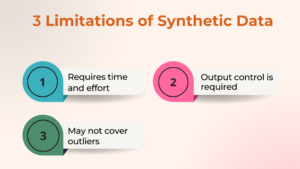Synthetic Data: The Definition, Guide, Importance, Use Cases and Challenges
Data is the lifeblood of any business, but it can be expensive and time-consuming to collect. This is where synthetic data comes in.
In certain cases, synthetic data is a cost-effective and an efficient way to generate the data you need without having to go through the hassle of collecting it yourself.
It is used in a lot of activities, including as test data for new products, for model validation, and in AI model training.
In this article, we’ll take a look at what synthetic data is, how it’s used, and some benefits it can offer your business.
Table of Contents
- What Is Synthetic Data?
- What Is The Importance Of Synthetic Data?
- What Are Its Limitations?
- Why Should You Use Synthetic Data?
- Use Case Of Synthetic Data
- Challenges Of Synthetic Data
Beginner’s Guide on What is Synthetic Data
If you’re new to the world of synthetic data, here’s a beginner’s guide on what you should know. It is artificial data that is generated by algorithms.
It can be used to train machine learning models and also to test data-driven applications. This allows you to avoid having to gather a lot of data by yourself or pay someone else to do it for you.
When you use such data, you’re not just using an algorithm to generate a file. You’re actually “creating” the data that the algorithm needs to get accurate results and train properly.
This is a key distinction that sets synthetic data apart from machine learning data.
So where do you get this type of data? The most basic kind of synthetic data can be generated by simply “playing” around with algorithms.
If you play around with a model enough, even if you create models that don’t make sense and come up with bad predictions, you will still get some of this data.
Importance of Synthetic Data
Synthetic data is data that is generated by artificial means, usually by computer programs. It is even used sometimes to supplement real data in order to test machine learning algorithms.
As machine learning becomes more popular, the need for this data increases. This is because machine learning algorithms require a lot of data in order to be effective.
Who Uses Synthetic Data?
It is used by researchers and data scientists in many fields. Some use it to test algorithms and tools, while others use it for research purposes.
One of the most popular machine learning fields is computer vision. In this field, synthetic data is used to test algorithms and the software used to train these algorithms.
In addition to AI, there are a lot of apps that can use this data: image processing, the Internet of Things, and natural language processing.
What are the Limitations of Synthetic Data?

While it can be used to train machine learning models, it has several limitations.
First, it is often generated using simplified models that do not accurately reflect
reality.
This can lead to models that perform well on synthetic data but poorly on real-world data.
The quality of such data is highly dependent on the quality of the input data and the model used to generate the data.
The data may be biased due to bias in the input data. This data can only mimic the real-world data, but not make an exact copy.
This also means it may not throw up outliers that the original data has.
Grow your business operations using our data cleaning services
Finally, while synthetic data may improve a model’s performance, it is usually not representative of the actual data used in production.
It is almost always a very small subset of the data in production, and it may not contain the same features that a real-world application might use.
This can lead to inaccuracies in a model’s predictions.
How is Synthetic Data Created?
This type of data is created by artificial intelligence algorithms that generate data that looks like
real data but is not. Some artificial intelligence algorithms create data using simulated humans, while others generate data from natural language.
For example, a machine learning algorithm might be used to predict sentiment in sentences where it sees the word “good” used in context.
Another algorithm might learn to predict a financial asset price based on the stock market prices for that asset. In all of these cases, the data is generated by computer programs.
This artificial data plays a major role in building accurate models that can predict outcomes.
You can create synthetic data by developing a generative model from a dataset that already exists.
This creates new data that is the same as the original data. Such a generative model is one that learns from voluminous and real datasets to create data that correctly mimics the real world.
There are three such models: Generative Adversarial Networks or GANs, Variational Auto Encoders or VAEs, and Autoregressive models.
Use Cases for Synthetic Data
Synthetic data can be used to develop test cases for software development and testing. It can also be used to create training data for machine learning algorithms.
A synthetic data generator can be run multiple times to simulate different sets of input data. This data is processed using machine learning algorithms and validated using test sets.
It can be generated by a data scientist in response to the need of the company.
Such data sets are typically needed for model development and testing or for building training data for machine learning algorithms.
In the case of creating test cases for software development and testing, synthetic data can be used to gather test cases from actual users. It can also be used to build training data for machine learning algorithms.
If a data scientist has created the data sets for model development and testing, synthetic data can be used to validate the trained models and validate the software product once it is built.
Challenges of Synthetic Data
A big challenge of this data is that it can be very difficult to generate data that accurately represents reality.
This is because it is often hard to know all the factors that contribute to a real-world phenomenon.
There are several aspects of data that can be hard to replicate in a synthetic fashion. The type of data generated can also be hard to reproduce.
For example, you cannot replicate naturally random features in a synthetic data set.
Data that is generated in different environments can also be hard to recreate. All Y data has been validated, it can be used in subsequent runs to predict outcomes.
Why Use Synthetic Data?
There are many reasons to use this type of data. Perhaps the most obvious one is that it can be used to generate data that is not available in the real world.
This is useful for training machine learning models, as well as for testing and debugging those models.
Another reason to use this data is that it can be generated very quickly and cheaply. Once a set of features is created and tested, it can then be used to generate new data.
Grow your business operations using our data cleaning services
Synthetic data allows for better predictive analytics because the models are trained on real data that matches the original data but does not necessarily represent the real world as closely as real data does.
When you look at this data, the first thing that might catch your eye is its color. A good way to think about this type of data is as “fake” or “manipulated” data.
Although it is not truly random, it does not represent any real-world data.
So why would you use synthetic data in machine learning models? Such data can be used for many different purposes.
It is often used to support a modeling workflow, in which the model is first trained on real data and then tested on synthetic data to see if it is performing well or if there are problems with the model.
Another reason to use this data is that it provides training data for a dataset that does not actually exist in the real world.
In general, any time you want to test the predictive power of a machine learning model, it is a good idea to use this type of data as a substitute for real data.
In conclusion: In today’s business world, data is everything. It can be expensive and time-consuming to collect, but synthetic data can provide a cost-effective and efficient solution. In many cases, synthetic data is a better option than collecting real data, because it can be used for activities like testing new products, validating models, and training AI models.
Build sentiment analysis models with Oyster
Whatever be your business, you can leverage Express Analytics’ customer data platform Oyster to analyze your customer feedback. To know how to take that first step in the process, press on the tab below.
Liked This Article?
Gain more insights, case studies, information on our product, customer data platform

